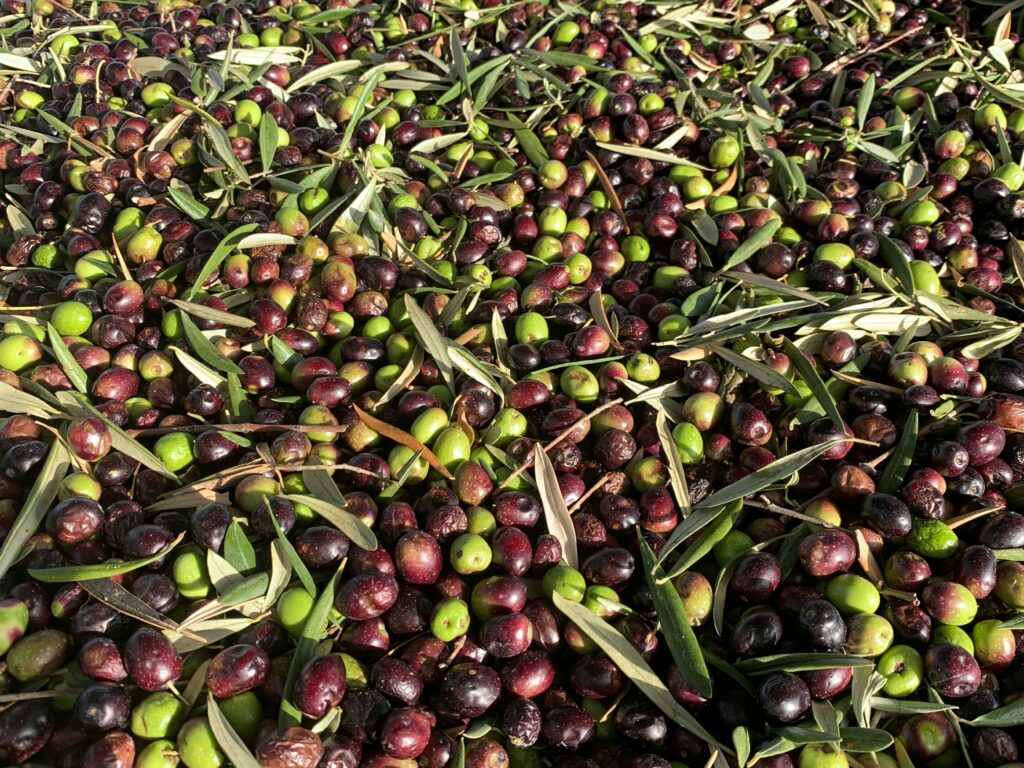Latium holds four extra virgin olive oils protected by a Designation of Origin: Sabina, Canino, Tuscia and Colline Pontine. From 2021, there is also a Protected Geographical Indication: Olio di Roma.
An overall picture showing the considerable dynamism of the regional olive oil sector, with about 82,000 hectares of land and an annual production of about 12,000 tons of oil, in the last years influenced by the general production loss.
A choice that takes into account the marked typicality of the regional products, the territorial macrorealities that have been able to find excellence in local areas,
Nowadays, all Latium provinces are involved in renovating their olive oil tradition, looking for opportunities of development in a market that finally seems to be sensitive to quality, recognition, and origin thanks to a new generation of consumers able to appreciate the differences among cultivars and interested to production methods.
In the Latium region there are over 300 oil mills, scattered throughout the region. A third of the oil mills still have traditional grindstones, whereas the remaining ones are fitted with modern continuous cycle oil presses (hammer crushers and centrifugal extraction).
Olive growing is very widespread and established within the region and offers ample margins of growth in terms of quality and quantity, but it still suffers from fragmentation of land and limited commercialization, with top quality products struggling to impose themselves outside the Roman market.
One of the main limitations to the regional olive oil sector’s potential is represented by the extreme fragmentation of the olive oil production in all its stages.
The majority of oil mills are very small and, during bad production seasons, they tend to remain closed; moreover, most of the oil produced is consumed at home or sold to local clients.

1. Sabina PDO extra virgin olive oil
The olive growing vocation of Sabina is based on a century-old tradition and on paedoclimatic conditions. The terrain, in particular, ranges from brown calcareous to dark Mediterranean soil. The climate is normally temperate and rarely reaches very high or very low temperatures. Olive growing is also favoured by hilly slopes and southern exposure, as well as altimetry, ranging from 200 metres in the Lower Sabina to 500 metres in the Upper Sabina.
However, the most important factor influencing the quality of this oil is the variety portfolio, with several varieties finding in Sabina their ideal growing conditions.The PDO Sabina product specification allows the use of Carboncella, Leccino, Raja, Pendolino, Frantoio, Moraiolo, Olivastrone, Salviana, Olivago, and Rosciola for minimum 75%. Other varieties can be used up to 25%. The production area includes 14 municipalities in the province of Rome and 32 municipalities in the province of Rieti.
In the extraction stage only mechanical and physical methods can be applied, so as to preserve the original characteristics of the olives. A peculiarity of this oil is its low acidity, reaching a maximum of 0.6%. The colour is golden yellow, with green tints in younger oils. The aroma is fruity and the flavour is fruity, velvety, uniform, aromatic, and slightly pungent. The bitter note is pronounced in younger oils, but tends to fade away over time.
2. Canino PDO extra virgin olive oil
Another protected regional extra virgin olive oil is Canino, produced in the province of Viterbo and registered since 1996. It is produced in the lands once feuds of the Torlonia family, an area vocated to olive growing since Etrurian times including the municipalities of Canino, Arlena, Cellere, Farnese, Ischia di Castro, Tessennano, and part of Tuscania and Montalto di Castro; the total cultivated surface is about 30,000 hectares. The main varieties are Canino, a local olive variety, Leccino, Pendolino, Maurino, and Frantoio, either in purity or blended. The acidity, ranging from 0.15% to 0.5%, is one of the lowest among Italian extra virgin olive oils. The oil has a green color with golden hues, a fruity odor, and a pronounced flavor, slightly pungent when young and with a bitter aftertaste.
3. Tuscia PDO extra virgin olive oil
The third protected regional extra virgin olive oil is Tuscia, registered in 2005. The designation refers to the oil produced in 52 municipalities in the province of Viterbo.
The local Canino, a small and slow ripening olive variety, allows the production of a low-acidity oil (maximum 0.5%) with a green color, a fruity odor, and a pronounced flavor. Other varieties include Frantoio, Moraiolo, and Leccino, as well as Maurino and Pendolino.
4. Colline Pontine PDO extra virgin olive oil
The Colline Pontine extra virgin olive oil, that has obtained the Designation of Origin in 2010, is produced in the province of Latina and is characterised by a yellow-green colour more or less intense and a pronounced fruitiness; it also has a fruity taste with bitter and pungent notes.
The olive oil is produced from the following varieties: Itrana from 50% to 100%, Frantoio and Leccino up to 50%. Other varieties may be used up to a maximum of 10%. Olive growing and milling must take place in the area mentioned in the product specification. Production cannot exceed 100 kg per plant.
Olives are picked by hand or mechanically and nets are used to avoid the crushing of olives fallen to the ground.
Olive milling takes place within 48 hours of harvesting and only physical and mechanical means can be used. The kneading stage must take place at 33°C for a maximum of 50 minutes. The oil yield must not exceed 27%.
5. Olio di Roma PGI extra virgin olive oil
The Olio di Roma extra virgin olive oil, that has obtained the Protected Geographical Indication in August 2021, is the most recent of the region’s olive oil designations. Production includes the entire province of Viterbo and numerous municipalities in the province of Frosinone, Latina, Rieti and Rome.
The product specification allows the use of Itrana, Carboncella, Moraiolo, Caninese, Salviana, Rosciola, Marina, Frantoio and Leccino olive varieties for a minimum of 70%. Other varieties are allowed up to a maximum of 30%.
The oil is characterized by a color varying from green to golden yellow. The fruity odor varies in intensity with evident notes of tomato and/or artichoke and/or almond and/or grassy. The flavor is characterized by vegetal hints, bitter and spicy notes of varying intensity that can be associated with notes of tomato and/or artichoke and/or almond and/or grassy.
6. Other extra virgin olive oils produced in the Latium region
In the province of Rome, apart from Soratte, other productions are located in the territories of Castelli Romani and Terre Tiburtine.
In the province of Frosinone, the majority of the production is located in the Upper Ciociaria, particularly in the municipalities of Paliano, Piglio, and Serrone, where typical central Italian olive varieties are grown (Leccino, Frantoio, Moraiolo, Rosciola).
In the province of Latina, important production areas are located at the foot of the Lepini Mounts, around the town of Cori in particular, and in the Itri and Minturno territories; the olive varieties grown are: Frantoio, Leccino, and the local Itrana variety.
Finally, in the Agro Pontino, besides Itrana, also the local Minutella and Vallanella varieties are grown.
Discover some of the Lazio EVO oil excellences
The Rome EVO Award has a rich history of recognizing true excellence. We invite you to find out more about the remarkable individuals and companies who have built this legacy, showcasing a journey defined by innovation, leadership, and commitment to Italian excellence.
Click HERE to watch the videos featuring the different oil producers who have been honoured.



Add a comment